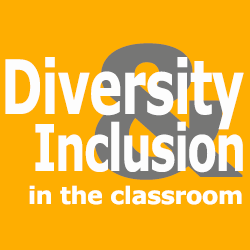Diversity, Equity, & Inclusion in the Classroom
 Inclusive learning environments are those in which all students feel valued and respected. As an institution, Cal Poly is working to increase the diversity of its faculty, staff, and student populations as well as to create a more inclusive campus climate. Educators play a key role in ensuring all students have an equitable chance of succeeding academically and feel a sense of belonging in our classrooms and on our campus. See the pages listed on the menu at the right or in the list below for ideas and strategies on how to create and maintain inclusive classrooms. Below is a listing of various programs and services.
Inclusive learning environments are those in which all students feel valued and respected. As an institution, Cal Poly is working to increase the diversity of its faculty, staff, and student populations as well as to create a more inclusive campus climate. Educators play a key role in ensuring all students have an equitable chance of succeeding academically and feel a sense of belonging in our classrooms and on our campus. See the pages listed on the menu at the right or in the list below for ideas and strategies on how to create and maintain inclusive classrooms. Below is a listing of various programs and services.
Building Community and Creating an Inclusive Learning Environment
The Building Community and Creating an Inclusive Learning Environment page presents selected best practices for connecting with your students, learning about them and the challenges they face, connecting students to each other, and assuring students that you are there to support their learning and success.
Student Pronouns and Preferred Names
Consistently using personal pronouns and preferred names is key for creating a more inclusive campus culture.
Since March 2019, students, staff, and faculty have had the option to be listed in the Cal Poly directory under their preferred name.
Canvas users can now indicate their personal pronouns in their user settings. To learn more, visit What's New in Canvas.
To support faculty and staff in using personal pronouns and preferred names, the CTLT has prepared:
- Pronouns and Preferred Names Resource Page
- Pronouns And Preferred Names FAQ (Frequently Asked Questions)
Diversity, Equity, and Inclusion Syllabus Statements
One of the important ways that Cal Poly educators can help all students to be successful is to foster a class environment that is conducive to learning by establishing core commitments to inclusion and support of diversity. One effective way for faculty do this is by conveying their personal and professional values for diversity and inclusion directly and clearly to students through a syllabus Diversity & Inclusion statement.
The page linked below provides guidance, resources and examples of Diversity & Inclusion statements. The statement language can also be useful whenever faculty recognize the need to restate their personal and professional support for Diversity & Inclusion when incidents in class, on campus, or elsewhere undermine students' sense of inclusion and belonging at Cal Poly.
Acknowledge and Respond to Distressing Events
When distressing events occur on campus, in the surrounding community, or at a broader level, it is important to think deeply about how these events impact the learning experience and may harm students that are personally affected. This page provides guidance for acknowledging events or circumstances with your students, whether you decide to engage in conversation or not, as well as resources for conducting conversations or classroom activities related to distressing events.
Strategies for Equity and Inclusion in Virtual Instruction
The Strategies for Equity and Inclusion in Virtual Instruction guide is intended as a starting point for instructors to consider the ways in which they can intentionally build equity and inclusion in their virtual courses. The strategies presented here are not an exhaustive list but are intended to provide instructors with easy to implement, concrete suggestions for making equity and inclusion a priority in their courses, rather than an afterthought.
This guide contains the following sections:
- Overview of Strategies for Equity and Inclusion in Virtual Instruction
- Build Community and Promote Inclusion
- Show Compassion and Awareness
- Respond to Behavior that Detracts from Learning in the Virtual Environment
Book Circles on Diversity and Inclusion
Quarterly
CTLT regularly sponsors (and co-sponsors) book circles on diversity, equity, and inclusion topics during the academic year and over summer. They are open to all campus educators: faculty at all ranks and staff with an educational role. These are designed to prompt informed discussions within the campus community and to stimulate valuable insights that can Cal Poly to become a more inclusive campus. Click the Book Circles tile on the CTLT's Programs and Services page to see offerings for an upcoming quarter. If you are interested in co-facilitating a book circle or recommending a book, please contact Sarah Macdonald, Inclusive Excellence Instruction Specialist. Recent titles include:
- Teaching Community: A Pedagogy of Hope (bell hooks)
- Teaching Critical Thinking: Practical Wisdom (bell hooks)
- Writing Beyond Race: Living Theory & Practice (bell hooks)
- Pedagogy of Freedom: Ethics, Democracy and Civic Courage (Paulo Freire)
- What Blood Won’t Tell: A History Of Race On Trial In America (Ariela Gross)
- Whistling Vivaldi: How Stereotypes Affect Us and What We Can Do (Claude Steele)
- Internationalizing The Curriculum (Betty Leask)
- Between the World and Me (Ta-Nehisi Coates)
- Colorblind (Tim Wise)
- Dear White America (Tim Wise)
- White Like Me (Tim Wise)
- Tyranny of the Meritocracy: Democratizing Higher Education in America (Lani Guinier)
- The Immortal Life of Henrietta Lacks (Rebecca Skloot)
- Underground Undergrads: UCLA Undocumented Immigrant Students Speak Out
- The Militarization of Indian Country (Winona LaDuke)
- White Fragility: Why It's So Hard for White People to Talk about Racism (Robin DiAngelo)
- Black Prophetic Fire (Cornel West)
- The Culturally Inclusive Educator: Preparing for a Multicultural World (Dena R. Samuels)
- Why Are All the Black Kids Sitting Together in the Cafeteria? And Other Conversations About Race (Beverly Daniel Tatum)



